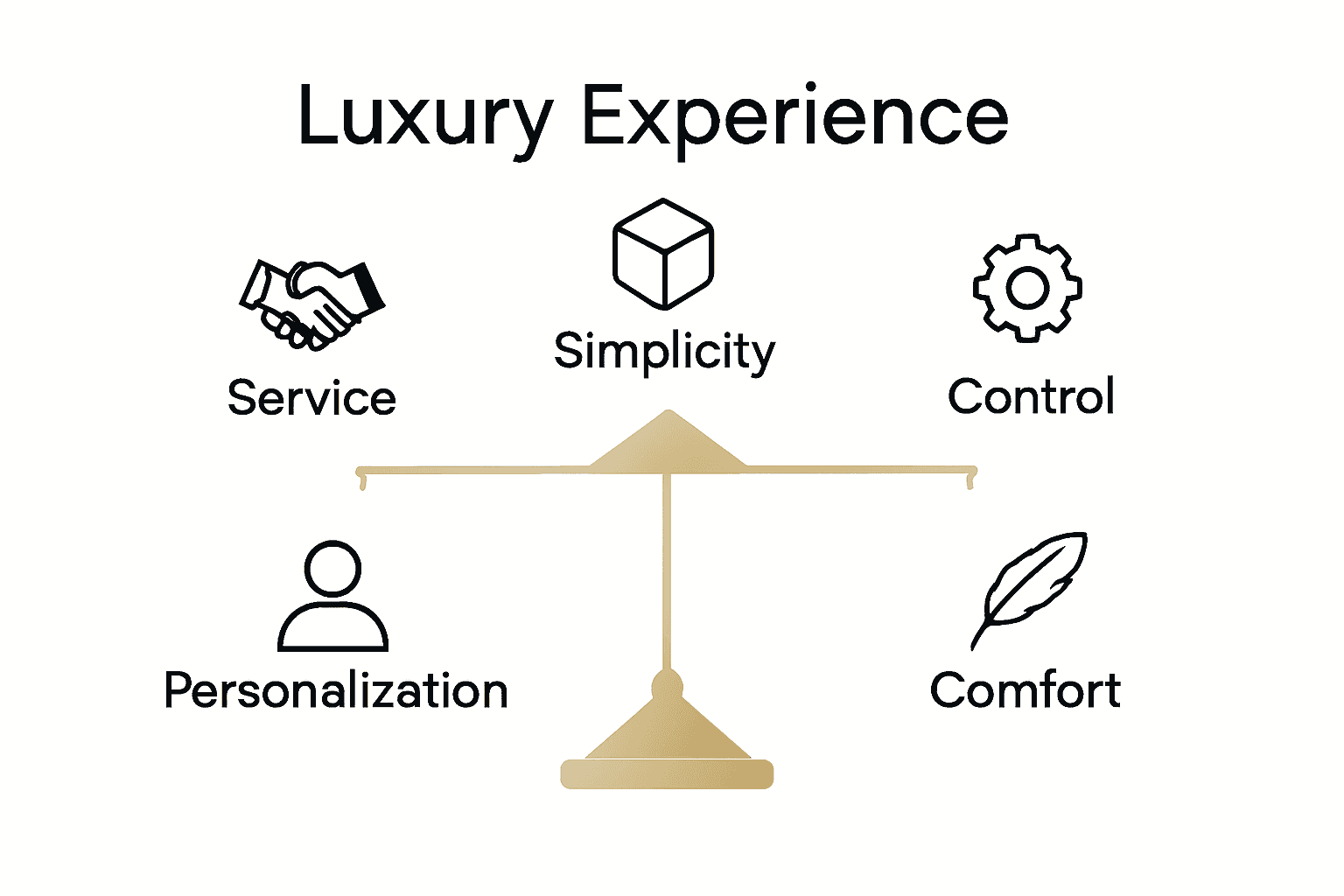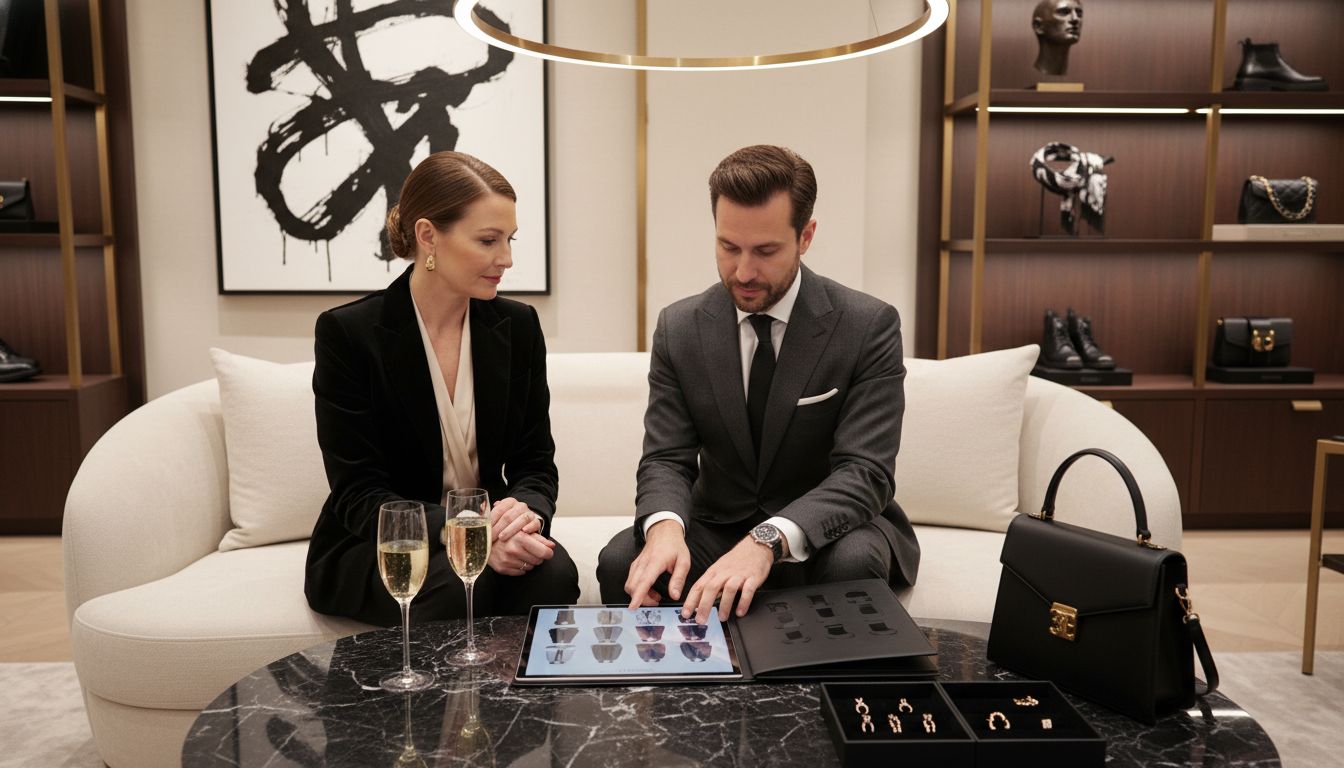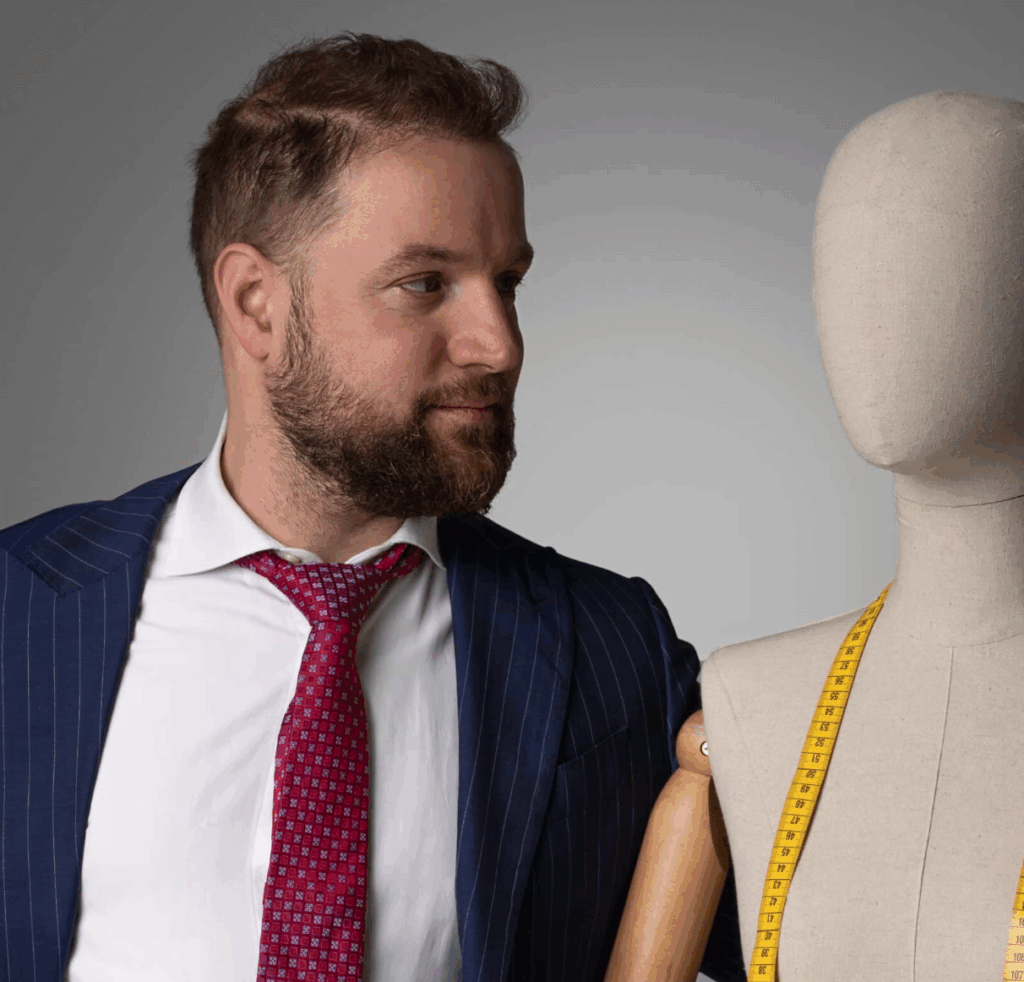More than 70 percent of luxury consumers expect personalized, emotionally resonant experiences at every stage of their journey. In the world of luxury, each interaction is carefully designed to make clients feel valued and understood on a deeper level. Understanding what defines a truly exceptional luxury customer journey helps brands create lasting loyalty and stand out in a market where expectations are always rising.
Table of Contents
- Defining Customer Journey In Luxury
- Key Phases Of The Luxury Experience
- Psychological Drivers Behind Luxury Purchases
- Role Of Digital And In-Person Touchpoints
- Common Pitfalls And Keys To Customer Loyalty
Key Takeaways
| Point | Details |
|---|---|
| Luxury journeys are complex | The customer journey in luxury transcends traditional experiences, focusing on emotional and psychological engagement rather than mere transactions. |
| Five essential dimensions | Successful luxury experiences hinge on service, simplicity, personalization, comfort, and control to meet high client expectations. |
| Phases of luxury experience | The luxury customer journey includes awareness, research, engagement, purchase, and post-purchase phases that require exceptional personalization. |
| Customer loyalty is crafted | Brands must avoid pitfalls like inconsistent experiences and inadequate personalization to nurture genuine, lasting loyalty among high-end clientele. |
Defining Customer Journey in Luxury
The customer journey in luxury represents a complex, nuanced experience that transcends traditional transactional interactions. Unlike standard consumer pathways, luxury journeys are deeply psychological, emotional, and meticulously crafted to create profound connections between brands and high-net-worth individuals.
According to the eprints research, luxury customer experiences are multidimensional, involving six critical factors that shape the entire engagement. These factors go far beyond simple product acquisition, focusing instead on creating immersive, personalized narratives that resonate with sophisticated consumers. The research highlights that luxury experiences are not linear but intricate, interconnected interactions that engage multiple sensory and emotional touchpoints.
Building on this understanding, the Yanfeng Luxury Study reveals five essential dimensions that elevate customer experiences:
- Service: Exceptional, anticipatory, and personalized interactions
- Simplicity: Effortless and intuitive engagement processes
- Personalization: Tailored experiences reflecting individual preferences
- Comfort: Seamless and stress-free interactions
- Control: Empowering customers with choice and agency
These dimensions demonstrate that luxury customer journeys are intricate psychological landscapes where emotional intelligence, precision, and individual recognition converge.
 Brands must move beyond transactional thinking and embrace a holistic approach that treats each interaction as an opportunity to craft an extraordinary, memorable narrative.
Brands must move beyond transactional thinking and embrace a holistic approach that treats each interaction as an opportunity to craft an extraordinary, memorable narrative.
Key Phases of the Luxury Experience
The luxury customer journey represents a sophisticated, multi-stage process that goes beyond traditional consumer interactions. Unlike standard purchasing experiences, luxury journeys are intricate psychological and emotional pathways that demand exceptional attention to detail and personalized engagement.
According to Media Avataar, the luxury customer journey encompasses several critical phases that transform a simple transaction into an extraordinary experience. These phases are not merely sequential steps but interconnected emotional touchpoints that require brands to demonstrate deep understanding and anticipation of high-end client expectations.
The key phases of the luxury experience typically include:
-
Awareness and Inspiration
- Discovery through curated channels
- Emotional connection with brand narrative
- Aspirational positioning
-
Research and Exploration
- Detailed product investigation
- Immersive digital and physical experiences
- Personalized consultation opportunities
-
Engagement and Interaction
- Bespoke communication
- White-glove customer service
- Tailored recommendations
-
Purchase and Acquisition
- Seamless, exclusive transaction process
- Personalized delivery experience
- Celebratory moment of ownership
-
Post-Purchase Relationship
- Continued brand engagement
- Exclusive aftercare services
- Lifetime customer relationship management
Building on these insights, the Yanfeng study reinforces that successful luxury experiences must balance five critical dimensions: service, simplicity, personalization, comfort, and control. Each phase of the journey must meticulously integrate these elements to create a truly exceptional, memorable engagement that transcends traditional consumer expectations.

Psychological Drivers Behind Luxury Purchases
Luxury purchases represent far more than simple transactions—they are profound psychological expressions of identity, aspiration, and self-perception. Emotional intelligence plays a critical role in understanding why individuals invest in premium experiences and products that transcend mere functional utility.
According to Media Avataar, consumers are driven to luxury fashion brands by the powerful psychological desire to belong to a selected tribe and showcase personal connoisseurship. This tribal belonging isn’t just about ownership, but about communicating complex social narratives and personal achievements through carefully curated brand choices.
The primary psychological drivers behind luxury purchases can be categorized into several nuanced dimensions:
-
Social Signaling
- Demonstrating status and achievement
- Communicating refined taste and discernment
- Establishing social hierarchies through consumption
-
Emotional Fulfillment
- Creating personal moments of joy and validation
- Experiencing a sense of extraordinary experience
- Rewarding personal milestones and accomplishments
-
Identity Construction
- Expressing personal values and aesthetic preferences
- Crafting a sophisticated personal narrative
- Reinforcing self-perception and aspirational self-image
Building on these insights, the Yanfeng study emphasizes that luxury consumers fundamentally seek experiences rooted in deep understanding and anticipation of their unique preferences. This profound expectation transforms luxury consumption from a transactional interaction into an intimate, trust-based relationship where brands must demonstrate exceptional empathy and personalization.
Role of Digital and In-Person Touchpoints
The luxury customer experience is a delicate ecosystem where digital and physical touchpoints must seamlessly integrate to create a cohesive, immersive journey. Modern luxury consumers expect an omnichannel experience that effortlessly transitions between digital interactions and physical encounters, demanding unprecedented levels of consistency and personalization.
According to Wikipedia (en anglais), touchpoints represent the critical first interactions customers have with a company, serving as the foundational starting point of the customer journey and profoundly influencing the overall experience. In the luxury sector, these touchpoints are not mere interaction points but carefully orchestrated moments of connection that communicate brand values, emotional narratives, and exclusive positioning.
The key digital and in-person touchpoints in luxury experiences include:
Digital Touchpoints:
-
Website and Mobile Platforms
- Immersive visual storytelling
- Personalized product recommendations
- Virtual consultation features
-
Social Media Channels
- Behind-the-scenes brand narratives
- Interactive client engagement
- Exclusive content previews
Physical Touchpoints:
-
Flagship Stores
- Curated spatial experiences
- Personal styling consultations
- Exclusive event invitations
-
Boutique Interactions
- White-glove customer service
- Personalized product demonstrations
- Bespoke fitting experiences
The Mobile Ethnography research highlights an emerging trend of utilizing mobile devices to gather real-time data, effectively bridging digital and physical touchpoints. This technological approach enables luxury brands to create increasingly personalized, responsive, and anticipatory customer experiences that transcend traditional service models.
Common Pitfalls and Keys to Customer Loyalty
In the intricate world of luxury experiences, customer loyalty is not a given but a meticulously crafted outcome of strategic, empathetic interactions. Brands must navigate a complex landscape where a single misstep can permanently erode the delicate trust established with high-end clientele.
According to Media Avataar, understanding and anticipating customer expectations is fundamental to fostering genuine loyalty in luxury markets. The most successful brands recognize that loyalty transcends transactional relationships, requiring a profound commitment to personalization, emotional connection, and consistent excellence.
Common Pitfalls That Undermine Customer Loyalty:
-
Inconsistent Experience
- Variance in service quality across touchpoints
- Misalignment between digital and physical interactions
- Lack of personalized follow-up
-
Inadequate Personalization
- Generic communication strategies
- One-size-fits-all approach to client engagement
- Failure to recognize individual client history
-
Communication Breakdown
- Slow or unresponsive customer service
- Lack of proactive communication
- Insufficient transparency
Keys to Cultivating Loyalty:
-
Anticipatory Service
- Predictive personalization
- Proactive problem resolution
- Exclusive, tailored experiences
-
Emotional Connection
- Genuine brand storytelling
- Consistent value alignment
- Meaningful client relationships
The Yanfeng study emphasizes that luxury experiences depend on the intelligent orchestration of multiple aspects. Any imbalance can transform an extraordinary journey into a mundane interaction, ultimately risking client retention. Successful luxury brands must maintain a delicate equilibrium of service, personalization, and emotional intelligence.
Elevate Your Luxury Customer Journey with Psychology-Driven Marketing
Crafting an extraordinary luxury customer journey means mastering the delicate balance of personalization, emotional connection, and seamless touchpoints highlighted in the article. If you are looking to transform your client’s experience with strategies grounded in consumer psychology and detailed luxury consulting, our services at Corrado Manenti offer exactly that. We understand the critical phases of awareness, engagement, and loyalty and help you design marketing campaigns that resonate deeply, turning every interaction into a memorable moment.

Explore how a psychology-driven approach can redefine your brand presence in the luxury sector by visiting our Marketing de la mode category. Ready to create emotionally intelligent strategies that captivate and retain high-end clients? Visit Corrado Manenti now and take the first step toward an expertly crafted luxury customer experience that stands apart in today’s competitive market.
Frequently Asked Questions
What are the key phases of the luxury customer journey?
The key phases of the luxury customer journey include Awareness and Inspiration, Research and Exploration, Engagement and Interaction, Purchase and Acquisition, and Post-Purchase Relationship. Each phase involves interconnected emotional touchpoints that enhance the overall experience.
How can personalization enhance the luxury customer journey?
Personalization enhances the luxury customer journey by offering tailored experiences that reflect individual preferences, which fosters emotional connections and builds loyalty between the customer and the brand.
What psychological drivers influence luxury purchases?
The primary psychological drivers of luxury purchases include social signaling, emotional fulfillment, and identity construction. These factors go beyond mere transactions and encapsulate personal values, aspirations, and emotional experiences associated with luxury products.
How do digital and physical touchpoints integrate to improve luxury experiences?
Digital and physical touchpoints integrate to create a cohesive luxury experience by ensuring seamless transitions between online and offline interactions. This includes personalized recommendations on digital platforms and bespoke services in physical locations, enhancing overall engagement.



